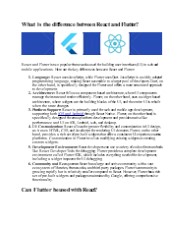Widget Toolkits and Component Technology - PowerPoint PPT Presentation
1 / 30
Title:
Widget Toolkits and Component Technology
Description:
Examples: Why not just remove the options? Active / Inactive ... cross-platform usage. Interoperability. use with other components. Fast and easy to use ... – PowerPoint PPT presentation
Number of Views:49
Avg rating:3.0/5.0
Title: Widget Toolkits and Component Technology
1
Widget Toolkits andComponent Technology
Computer Science 160 Fall 1998
2
Widget Toolkit Overview
- Widget Properties
- Affordance
- Grouping
- Widget Look and Feel
3
Widget Properties
- Acquired / Released
- Enabled / Disabled
- Active / Inactive
- Echo
4
Acquired / Released
- Only a few logical functions active at a time
- If a logical input has its resources allocated,
then it is acquired - Example - Menu systems
5
Enabled / Disabled
- Input to widget does not make sense
- Examples
- Why not just remove the options?
6
Active / Inactive
- Need to know if the widget is responding to user
input (feedback). - Examples
7
Echo
- How the widget reflects its current state
- Examples
8
Affordance
- What can be manipulated
- What happens when object is manipulated
9
Grouping
- Can group widgets
- Proximity and visual similarity
- Should group related widgets
- Menus
- Palettes
- Button bars
- Why?
10
Grouping (2)
- Visual Structure
- easier to find things
- Screen space
- Cannot display all controls at once
- Makes sense to group things for searching
- 7 /- 2 chunks
11
Optimized for Screens
- Should require minimal screen space
- Still have visual feedback and functionality
12
Look and Feel
- Ease of Learning
- what each widget is for and how to use it
- consistency is key
13
Look and Feel (2)
- Ease of Use
- is it easy or difficult for users to manipulate?
- Consistency is key
- make buttons look like buttons
- make menus look like menus
- visual processing can discard irrelevant info
14
Look and Feel (3)
- Attractive and Engaging
- looks good!
- but dont forget functionality
15
Transition
- That is all for Widget Toolkits
- Time to move on to Component Technology
16
Component Tech Overview
- Components?
- ActiveX
- JavaBeans
- CORBA
17
Components?
- Reusability
- standard interfaces interchangeable parts
- Portable
- cross-platform usage
- Interoperability
- use with other components
- Fast and easy to use
18
Component Examples
- Delphi
- Visual Basic
- JavaBeans
- OpenDoc (defunct)
19
Whats the Big Deal?
- How are components different from class libraries
or GUI widgets? - Design-Time interfaces
- Builder tools can query components
- Determine properties of component
- Determine events component responds to
- Determine what methods it has
- No source code necessary!
20
Whats the Big Deal? (2)
- Examples
Super Mojo
Visual Cafe
21
Whats the Big Deal? (3)
- Domain experts rather than coders can use
components - Could this be the next Silver Bullet?
- Buy and use someone elses code easily
- Reduce development time
- Reduce bugs!
22
ActiveX
- Microsofts approach to components
- Refers to the set of technologies and tools
- cross-platform
- language-independent
- networked environments
- Roughly equivalent to Java applets
23
ActiveX (2)
- Based on Common Object Model (COM)
- Network based is called DCOM
- Every ActiveX control comes with identifiers that
describe its interfaces (GUID) - Can query an ActiveX control for supported
interfaces - Then call the method through standard library
24
ActiveX (3)
- Advantages
- Works on Windows and Macintosh systems
- Can be created using several languages and tools
25
JavaBeans
- Component model for Java
- A Bean is a reusable software component that can
be visually manipulated in builder tools. - AWT widgets are JavaBeans too
26
JavaBeans (2)
- Difference between Bean and Class is
Introspection - look inside a bean to determine properties
- Uses well-defined patterns and conventions
- e.g. setX() and getX() accessor and modifier
- Can define own PropertyEditor
27
JavaBeans (3)
- Advantages
- Open standard (Javasoft)
- Disadvantages
- Open standard
- Existing tools and support (getting better)
28
CORBA
- Common Object Request Broker Architecture
- Object communications structure
- Key idea is the ORB - Object Request Broker
- Essentially middleware
- Remote Procedure Calls (RPC)
- Database stored procedures
29
Summary
- Components are reusable software objects
- Key is well-defined interfaces
- Design time usage
- Welcome to your future in programming
30
Summary
- Have a Happy Thanksgiving































